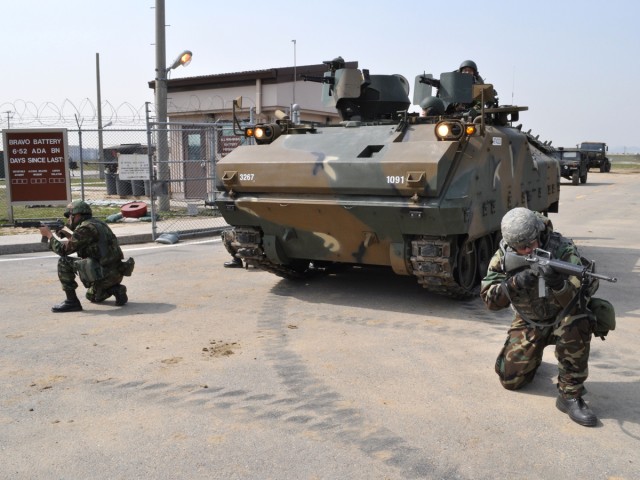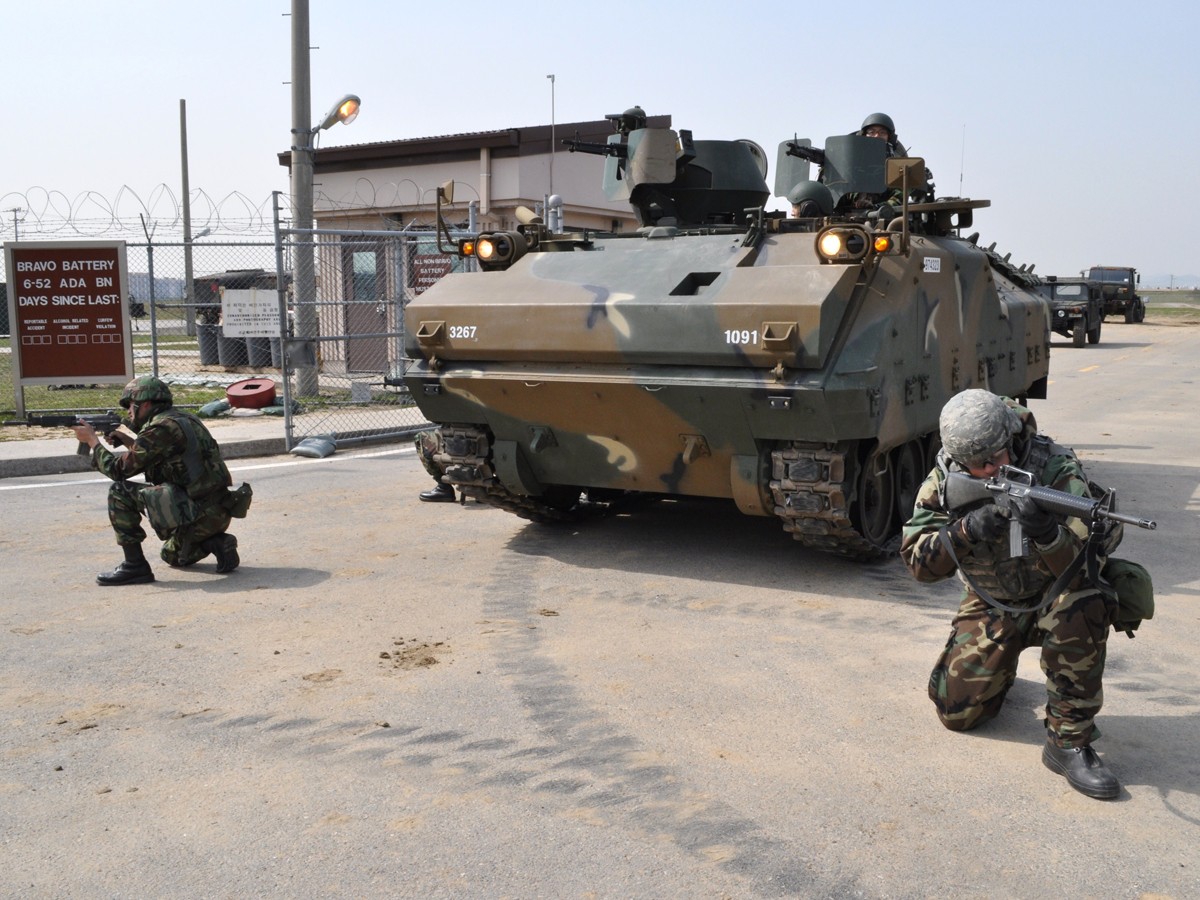SUWON AIR BASE, South Korea - They might have been sleep-deprived and drenched in mud and sweat, but Soldiers from the 6th Battalion, 52nd Air Defense Artillery Battalion concluded a week-long field training exercise with a renewed sense of pride and confidence in their equipment, their comrades-in-arms and most importantly, themselves.
The comprehensive air defense artillery field training exercise, which took place from May 2 - 6 across the peninsula, put to test the air defenders' ability to not only fulfill their primary mission of protecting the sky over South Korea, but also to execute combined force protection and logistical resupply missions with adjacent U.S. and Republic of Korea units.
The exercise included realistic scenarios that prepared the Iron Horse Soldiers mentally and physically to fight, survive and prevail on the battefield.
On Suwon Air Base, Pfc. Harley Farnsworth and the rest of his crew from B Battery, 6-52nd Air Defense Artillery Battalion had just received the order to reload one of the Patriot launching stations.
The crews immediately dashed toward the launcher, their ballistic armor plates weighing heavily upon them as they quickly went through the steps to reload the spent canister utilizing the guided missile transport.
Farnsworth and his crew understood perfectly well that innocent lives depended on whether they can successfully accomplish their missions in a timely manner.
"We are the ones who keep the air battle going and the missiles firing," said the Houston, Texas native.
His crews successfully passed the missile reload evaluation during the exercise.
"I am very proud of myself and my crew's ability to accomplish the mission," Farnsworth said.
Just as the missile reload evaluation was winding down, a few miles down the road, another group of Soldiers were being tested on their skill to conduct aerial missile resupply missions.
Near the Suwon Air Base flight line, Soldiers from Alpha Company, 602nd Aviation Support Battalion, along with personnel from Foxtrot Company, 6-52nd Air Defense Artillery Battalion, eagerly awaited the arrival of the CH-47D.
The helicopter, assigned to 3-2 General Support Aviation Battalion, would be slinging Patriot missile canisters across treacherous terrain to a distant firing unit running dangerously low on ammunition.
"This [aerial resupply] training validates the battalion's ability to coordinate for air support from 3-2nd GSAB and resupply its fire units even during degraded road conditions," said 1st Lt. Stephen Bonner of Foxtrot Company, 6-52nd ADA Battalion and one of the primary coordinators for the sling load operation.
Bonner continued, "The more times we do training such as this, the more comfortable we will be when we have to conduct aerial resupply missions during wartime."
Aside from air defense operations, the exercise also challenged U.S. and ROK Soldiers and airmen stationed at Suwon Air Base on their ability to conduct combined base defense and force protection operations.
At a ROK comand post, a U.S. liaison officer had just been notified that a suspected breach had been detected near one of 6-52nd Air Defense Artillery Battalion's facilities.
Within minutes, two Republic of Korea Air Force K200 infantry fighting vehicles loaded with ROK soldiers swiftly arrived at the site of the potential infiltration.
Staff Sgt. James Forst, assigned to Foxtrot Company, 6-52nd Air Defense Artillery Battalion, with the help of an interpreter, explained the unfolding situation to the ROK security forces, as forces from both nations began pulling security around the breach and executed a combined cordon and search operation.
Forst, a New York native and the noncommissioned officer-in-charge in charge of Fox Company's quick reaction force, thought that "the training was a great opportunity for U.S. Soldiers to learn how to work with their ROK counterparts here on Suwon Air Base."
Republic of Korea Air Force Maj. Kang Bong-suk, the chief of Suwon Air Base Ground Operation Center, who observed the training, also shared similar sentiment.
"I feel this exercise really strengthened the understanding and bond between U.S. 6-52nd ADA Battalion and ROK 10th Fighter Wing," said Bong.
The exercise concluded with a combined chemical, biological and radilogical decontamination operation of personnel and vehicles.
Bravo Battery, 6-52nd Air Defense Artillery Battalion was called upon to conduct operational decontamination for a U.S. and ROK unit returning to Suwon Air Base from a possibly contaminated area. As rows of U.S. and ROK Soldiers and armen passed through the decontamination stations and began protective gear exchange, the similarities between the gear and procedures of the two allied nations helped to alleviate the communication barrier between the two nations.
Sgt. Michael Camp, one of the primary trainers for the decontamination exercise, said, "The intent of the operation is to familiarize both parties involved of each other's gear, equipment and tactics, techniques and procedures."
Camp went on, "This type of training is very beneficial because there is always a good chance that we might be called upon to decontaminate our ROK counterparts here at Suwon or vice versa."
"I think the Iron Horse Battalion has once again proved its ability to successfully conduct air and missile defense operations," said Maj. Frederick Ramirez, the 6-52nd ADA Battalion Operations Officer-in-Charge. "However, I think the most significant improvement we have witnessed this week is the increased level and proficiency in the coordination and cooperation between our battalion and the ROKAF 10th Fighter Wing in executing combined force protection measures."


Social Sharing